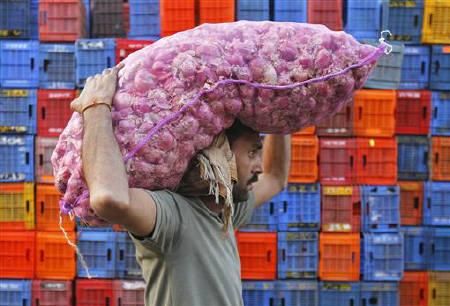This year, the warning signals about the impending onion crisis in the lean season were available as early as February, when unseasonal rain and hailstorms damaged the standing crop in several onion-producing states.
 Since the 1980s, the problem of regular spikes in onion prices has been allowed to persist, with virtually no attempt made to find a lasting solution.
Since the 1980s, the problem of regular spikes in onion prices has been allowed to persist, with virtually no attempt made to find a lasting solution.
Successive governments used knee-jerk responses - emergency imports, export curbs, stock restrictions and anti-hoarding drives under the Essential Commodities Act.
Such panic reactions treat, or rather suppress, the symptoms while letting the disease get worse.
This is because such measures tend to lower consumer prices - but without stimulating production to improve supply. Inept produce management also contributes to wide seasonal fluctuations in the prices of this politically sensitive kitchen staple.
Though three crops of onions are raised in a year - early kharif, late kharif and rabi - their harvests are not evenly spread out.
Thus, no harvest comes to the market between June and August; demand has to be met through the stocks stored from the rabi crop harvested in March-April.
If adequate storage-cum-preservation is discouraged through deterrent actions, a supply crunch in the lean season, of the kind experienced this year, is inevitable.
This year, the warning signals about the impending onion crisis in the lean season were available as early as February, when unseasonal rain and hailstorms damaged the standing crop in several onion-producing states.
Surprisingly, no government agency, not even the prices and production forecasting unit of the agriculture ministry, seemed to capture these warning signs.
Timely action at that stage - perhaps by using the Price Stabilisation Fund to buy onion stocks for safekeeping, or by organising imports - could have considerably blunted the impact of the output shortage on supply and prices during the off-season.
Dehydration of onions to extend their shelf life is another option. But even when the crisis peaked, the government took ages to react.
It was outwitted by private trade even in sourcing onions from abroad. While the government agencies were still in the process of issuing the tenders for imports, traders in the north were already getting consignments from Afghanistan by road via Pakistan through the Attari-Wagah border.
The long-term solution to onion price volatility lies in raising the productivity of onion growers, and judicious management of the available supplies.
For this, effective monitoring of production and prices is essential.
The average yield of onions in India, around 15 tonnes a hectare, is far lower than the global average of 19-20 tonnes.
It can be raised by creating incentives for farmers to use yield-enhancing inputs like irrigation water, fertilisers and plant protection chemicals. But this is possible only if the growers are assured of adequate returns through stable external and internal marketing policies.
Most onions are produced in three states - Maharashtra, Madhya Pradesh and Karnataka - and marketed through 50-odd major mandis managed by agricultural produce marketing committees (APMCs).
A multiplicity of intermediaries and their commissions, besides high market levies, adds to consumer costs.
The growers get just a small portion, usually less than half, of the price paid by the consumers.
Much of this could be avoided by revamping the supply chain to bridge the gap between producers and consumers through marketing reforms.
Photograph: Reuters











